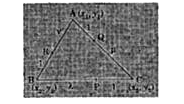A(x1,y1),B(x2,y2),C(x3,y3) are the vertices of a triangle ABC and ax+by+c=0 is the equation of the line L, then answer the following questions.
If a line ax+by+c=0 cuts the sides BC,CA and AB of triangle ABC at points P,Q and R respectively The prove that
BPPC.CQQA.ARRB=−1

The correct Answer is:−1
Topper's Solved these Questions
- RECTANGULAR CARTESIAN CO-ORDINATE SYSTEM AND THE STRAIGHT LINEBOOK - ML KHANNACHAPTER - RECTANGULAR CARTESIAN CO-ORDINATE SYSTEM AND THE STRAIGHT LINEEXERCISE - ASSERTION/REASON
1 Video
- PROPERTIES OF TRIANGLES BOOK - ML KHANNACHAPTER - PROPERTIES OF TRIANGLES EXERCISE - Self Assessment Test (Multiple Choise Questions)
34 Videos
- SELF ASSESSMENT TEST BOOK - ML KHANNACHAPTER - SELF ASSESSMENT TEST EXERCISE - OBJECTIVE MATHEMATICS
16 Videos
Similar Questions
The lines L1:y−x=0 and L2:2x+y=0 intersect the line L3:y+2=0 at P and Q respectively . The bisectors of the acute angle between L1 and L2 intersect L3 at R .
Statement 1 : The ratio PR : RQ equals 2√2:√5
Statement - 2 : In any triangle , bisector of an angle divides the triangle into two similar triangles .
View SolutionIf in ΔABC,(a−b)(s−c)=(b−c)(s−a), prove that r1,r2,r3 are in A.P.
View SolutionA uniform one metre long rod AB of 17 kg weight I suspended horizontally from fixed supports by two vertical strings attached to points C and D on the rod at distances of 12 cm and 16 cm from A and B respectively .The strings at C and D can support weights of 10 kg and 9 kg respectively without breaking .Find where a weight of 2 kg can be attached to the rod without breaking either of the string .
View SolutionIf A(x_(1),y_(1)),B(x_(2),y_(2)) and C(x_(3),y_(3)) are the vertices of a triangle then excentre with respect to B is
View SolutionLet A(x_(1),y_(1),z_(1)),B(x_(2),y_(2),z_(2))&C(x_(3),y_(3),z_(3)) be the vertices of triangle ABC Let D,E and F be the midpoints of BC,AC&AB respectively Show that centroids of ABC&Delta DEF coincides.
View SolutionIf A(x1,y1),B(x2,y2)andC(x3,y3) are vertices of an equilateral triangle whose each side is equal to a, then prove that
∣∣ ∣ ∣∣x1y12x2y22x3y32∣∣ ∣ ∣∣ is equal to
View SolutionA triangle has vertices Ai(xi,yi) for i= 1,2,3,. If the orthocenter of triangle is (0,0) then prove that
∣∣ ∣ ∣∣x2−x3y2−y3y1(y2−y3)+x1(x2−x3)x3−x1y3−y1y2(y3−y1)+x2(x3−x1)x1−x2y1−y2y3(y1−y2)+x3(x1−x2)∣∣ ∣ ∣∣=0
View Solutionयदि एक समबाहु त्रिभुज के शीर्ष (x1,y1),(x2,y2),(x3,y3) तथा त्रिभुज की भुजाओं की लम्बाई 'a' है, तो सिद्ध कीजिए कि
∣∣ ∣ ∣∣x1y11x2y21x3y31∣∣ ∣ ∣∣=3a44
View SolutionA(x1,y1)B(x2,y2) and C(x3,y3) are the vertices and a,b and c are the sides BC,CA and AB of the triangle ABC respectively then the Coordinates of in centre are I=
View SolutionIf =∣∣ ∣ ∣∣2ax1y12bx2y22cx3y3∣∣ ∣ ∣∣=abc2≠0then the area area of the triangle whose vertices are (x1a,y1a),(x2b,y2b),(x3c,y3c)is:
View SolutionIf ∣∣ ∣ ∣∣2ax1y12bx2y22cx3y3∣∣ ∣ ∣∣=abc2≠0 , then the area of the triangle whose vertices are (x1a,y1a),(x2b,y2b)and(x3c,y3c)
View SolutionA triangle has vertices Ai(xi,yi) for i= 1,2,3,. If the orthocenter of triangle is (0,0) then prove that
∣∣ ∣ ∣∣x2−x3y2−y3y1(y2−y3)+x1(x2−x3)x3−x1y3−y1y2(y3−y1)+x2(x3−x1)x1−x2y1−y2y3(y1−y2)+x3(x1−x2)∣∣ ∣ ∣∣=0
View Solutionयदि एक समबाहु त्रिभुज के शीर्ष (x1,y1),(x2,y2),(x3,y3) तथा त्रिभुज की भुजाओं की लंबाई 'a' है तो सिद्ध कीजिए कि: ∣∣ ∣ ∣∣x1y11x2y21x3y31∣∣ ∣ ∣∣=3a44
View SolutionIf A(x1,y1),B(x2,y2) and C(x3,y3) are the vertices of a ΔABC and (x, y) be a point on the internal bisector of angle A, then prove that
b∣∣ ∣ ∣∣xy1x1y11x2y21∣∣ ∣ ∣∣+c∣∣ ∣ ∣∣xy1x1y11x3y31∣∣ ∣ ∣∣=0
where, AC = b and AB = c.
View SolutionIf A(x1,y1),B(x2,y2)andC(x3,y3) are vertices of an equilateral triangle whose each side is equal to a, then prove that
∣∣ ∣ ∣∣x1y12x2y22x3y32∣∣ ∣ ∣∣ is equal to
View SolutionIf A(x_(1), y_(1)), B(x_(2), y_(2)) , and, C(x_(3), y_(3)) are vertices of an equilateral triangle whose each side is equal to a, then prove that |(x_(1), y_(1), 2),(x_(2), y_(2), 2),(x_(3), y_(3), 2)|^(2) = 3a^(4) .
View Solution

